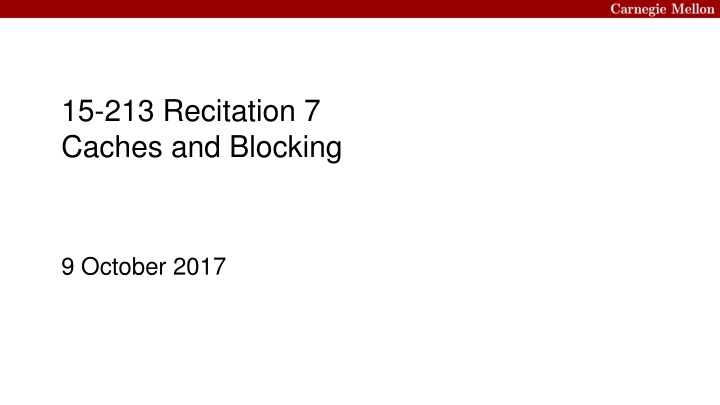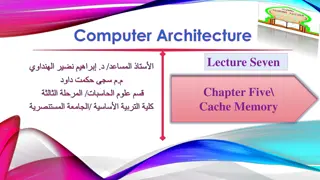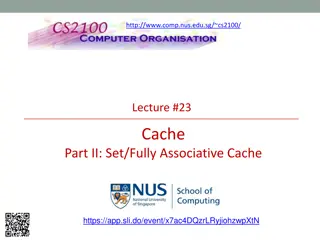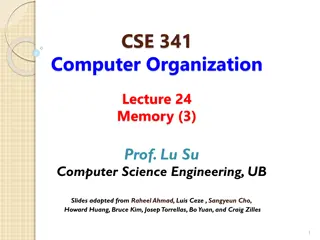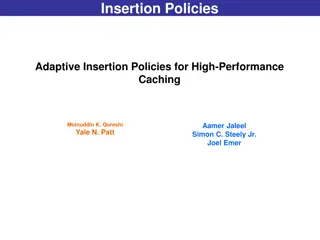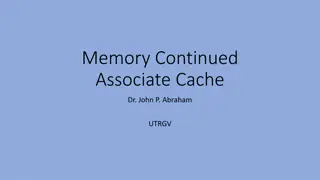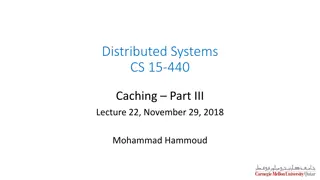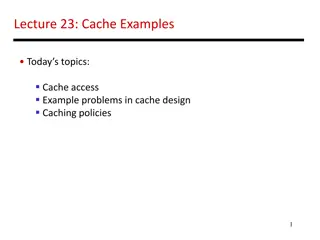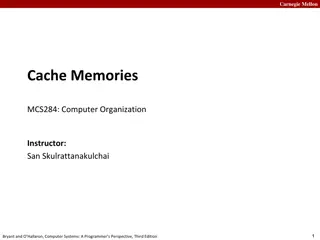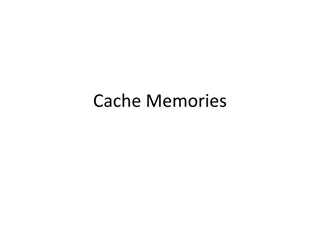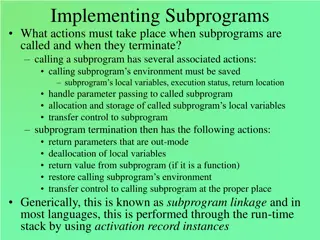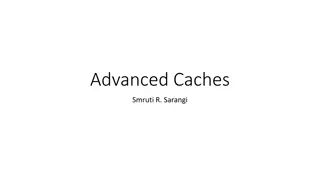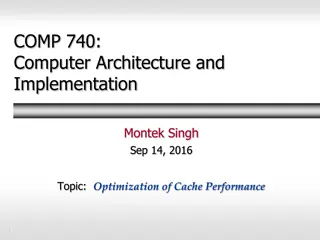Cache Lab: Enhancing Simulator Performance
Delve into the intricacies of cache labs, optimizing code to minimize cache misses, and implementing the parsing of input using fscanf. Explore cache alignment and structuring data for efficient cache simulation in a dynamic environment.
Download Presentation

Please find below an Image/Link to download the presentation.
The content on the website is provided AS IS for your information and personal use only. It may not be sold, licensed, or shared on other websites without obtaining consent from the author.If you encounter any issues during the download, it is possible that the publisher has removed the file from their server.
You are allowed to download the files provided on this website for personal or commercial use, subject to the condition that they are used lawfully. All files are the property of their respective owners.
The content on the website is provided AS IS for your information and personal use only. It may not be sold, licensed, or shared on other websites without obtaining consent from the author.
E N D
Presentation Transcript
15-213 Recitation 7 Caches and Blocking 9 October 2017
Agenda Reminders Revisiting Cache Lab Caching Review Blocking to reduce cache misses Cache alignment
Reminders Cache Lab is due Thursday! Exam1 is just a week away! Start doing practice problems. Come to the review session.
Reminders: Cache Lab Two parts Write a cache simulator Hopefully you've started this part by now Optimize some code to minimize cache misses Programming style will be graded starting now Worth about a letter grade on this assignment See the appendix. But that s incomplete, so also see the style guide on the course website. Other details are in the writeup.
Cache Lab: Parsing Input with fscanf fscanf() is exactly like scanf() except that you specify a stream to use (i.e. an open file) instead of always reading from standard input The parameters to fscanf are 1: a stream pointer of type FILE*, e.g. from fopen() 2: a format string specifying how to parse the input 3+: pointers to each of the variables that will store the parsed data fscanf() returns -1 if the data does not match the format string or there is no more input Use it to parse the trace files
fscanf() Example FILE *pFile; /* pointer to FILE object */ pFile = fopen( trace.txt , r ); /* open trace file for reading */ /* verify that pFile is non-NULL! */ char access_type; unsigned long address; int size; /* line format is S 2f,1 or L 7d0,3 */ /* so we need to read a character, a hex number, and a decimal number */ /* put those in the format string along with the fixed formatting */ while (fscanf(pFile, %c %lx,%d , &access_type, &address, &size) > 0) { /* do stuff */ } fclose(pFile); /* always close file when done */
Cache Lab: Cache Simulator Hints You are only counting hits, misses, and evictions Use LRU (Least Recently Used) replacement policy Structs are a great way to bundle up the different parts of a cache line (valid bit, tag, LRU counter, etc.) A cache is like a 2D array of cache lines One dimension represents set associativity E, the other the number of sets S: struct cache_line cache[S][E]; Your simulator needs to handle different values of S, E, and b (block size) given at run time Allocate your space dynamically
Class Question / Discussions We ll work through a series of questions Write down your answer for each question You can discuss with your classmates
What Type of Locality? The following function exhibits which type of locality? Consider only array accesses. void who(int *arr, int size) { for (int i = 0; i < size-1; ++i) arr[i] = arr[i+1]; } A. Spatial B. Temporal C. Both A and B D. Neither A nor B 9
What Type of Locality? The following function exhibits which type of locality? Consider only array accesses. void coo(int *arr, int size) { for (int i = size-2; i >= 0; --i) arr[i] = arr[i+1]; } A. Spatial B. Temporal C. Both A and B D. Neither A nor B 10
Calculating Cache Parameters Given the following address partition, how many int values will fit in a single data block? # of int in block A. 0 B. 1 C. 2 D. 4 E. Unknown: We need more info 18 bits 10 bits 4 bits Address: 31 0 Tag Set index Block offset 11
Interlude: terminology A direct-mapped cache only contains one line per set. This means E = 2e = 1. Memory 000 001 010 011 100 101 110 111 Cache (bytes) B0 B1 B0 B1 Cache (lines) L0 Cache (sets) S0
Interlude: terminology A fully associative cache has 1 set, and many lines for that one set. This means S = 2s = 1. Memory 000 001 010 011 100 101 110 111 Cache (bytes) B0 B1 B0 B1 Cache (lines) L0 Cache (sets) S0
Direct-Mapped Cache Example Assuming a 32-bit address (i.e. m=32), how many bits are used for tag (t), set index (s), and block offset (b). 8 bytes per data block Set 0: E = 1 lines per set Valid Tag Cache block Cache block Valid Tag Set 1: Set 2: Valid Tag Cache block t 1 s 2 2 4 4 4 b 3 3 3 8 8 Cache block Valid Tag A. B. C. D. E. Set 3: 27 25 1 20 t bits s bits b bits 31 0 Tag Set index Block offset 14
Which Set Is it? Which set may the address 0xFA1C be located in? 8 bytes per data block Set 0: E = 1 lines per set Valid Tag Cache block Cache block Valid Tag Set # for 0xFA1C A. 0 B. 1 C. 2 D. 3 E. More than one of the above Set 1: Set 2: Valid Tag Cache block Cache block Valid Tag Set 3: 27 bits 2 bits 3 bits 31 0 Tag Set index Block offset 15
Cache Block Range What range of addresses will be in the same block as address 0xFA1C? per data block 8 bytes Set 0: Valid Tag Cache block Addr. Range A. 0xFA1C B. 0xFA1C 0xFA23 C. 0xFA1C 0xFA1F D. 0xFA18 0xFA1F E. It depends on the access size (byte, word, etc) Cache block Valid Tag Set 1: Set 2: Valid Tag Cache block Cache block Valid Tag Set 3: 27 bits 2 bits 3 bits 31 0 Tag Set index Block offset 16
Cache Misses If N = 16, how many bytes does the loop access of A? Accessed Bytes int foo(int* a, int N) { int i, sum = 0; for(i = 0; i < N; i++) sum += a[i]; return sum; } 4 A 16 B 64 C 256 D
Cache Misses If there is a 48B cache with 8 bytes per block and 3 cache lines per set, how many misses if foo is called twice? N still equals 16 Misses int foo(int* a, int N) { int i, sum = 0; for(i = 0; i < N; i++) sum += a[i]; return sum; } 0 A 8 B 12 C 14 D 16 E
Cache-Friendly Code Keep memory accesses bunched together In both time and space (address) The working set at any time should be smaller than the cache Avoid access patterns that cause conflict misses Align accesses to use fewer cache sets (often means dividing data structures into pieces whose sizes are powers of 2)
Blocking Example We have a 2D array int[4][4] A; Cache is fully associative and can hold two lines Each line can hold two int values Discuss the following questions with your neighbor: What is the best miss rate for traversing A once? What order does of traversal did you use? What other traversal orders can achieve this miss rate?
Class Discussion What did the optimal transversal orders have in common? How does the pattern generalize to int[8][8] A and a cache that holds 4 lines each of 4 int s?
Cache-alignment Suppose you have arrays int[8] A, B, temp; A[0], B[0] and temp[0] all correspond to byte 0 of set 0 on the cache. We say that all three arrays are cache-aligned. For example, suppose we use a direct-mapped cache. If we request first A[0] then B[0], the cache will evict the line containing A[0].
Very Hard Cache Problem We will use a direct-mapped cache with 2 sets, which each can hold up to 4 int s. How can we copy A into B, shifted over by 1 position? The most efficient way? (Use temp!) A 0 1 2 3 4 5 6 7 B 0 1 2 3 4 5 6 7
temp 0 1 2 3 4 5 6 7 A 0 1 2 3 4 5 6 7 B 0 1 2 3 4 5 6 7 Number of misses:
temp 0 1 2 3 4 5 6 7 A 0 1 2 3 4 5 6 7 B 0 1 2 3 4 5 6 7 Number of misses: Could ve been 16 misses otherwise! We would save even more if the block size were larger, or if temp were already cached
If You Get Stuck Please read the writeup Read it again after doing ~25% of the lab CS:APP Chapter 6 View lecture notes and course FAQ at http://www.cs.cmu.edu/~213 Office hours Sunday through Thursday 5:00-9:00pm in WeH 5207 Post a private question on Piazza man malloc, man gdb, gdb's help command http://csapp.cs.cmu.edu/public/waside/waside-blocking.pdf
Appendix: C Programming Style Properly document your code Header comments, overall operation of large blocks, any tricky bits Write robust code check error and failure conditions Write modular code Use interfaces for data structures, e.g. create/insert/remove/free functions for a linked list No magic numbers use #define Formatting 80 characters per line Consistent braces and whitespace No memory or file descriptor leaks
